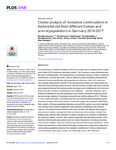Cluster analysis of resistance combinations in Escherichia coli from different human and animal populations in Germany 2014-2017
Suwono, Beneditta
Eckmanns, Tim
Kaspar, Heike
Merle, Roswitha
Zacher, Benedikt
Kollas, Chris
Weiser, Armin A.
Noll, Ines
Feig, Marcel
Tenhagen, Bernd-Alois
Recent findings on Antibiotic Resistance (AR) have brought renewed attention to the comparison of data on AR from human and animal sectors. This is however a major challenge since the data is not harmonized. This study performs a comparative analysis of data on resistance combinations in Escherichia coli (E. coli) from different routine surveillance and monitoring systems for human and different animal populations in Germany. Data on E. coli isolates were collected between 2014 and 2017 from human clinical isolates, non-clinical animal isolates from food-producing animals and food, and clinical animal isolates from food-producing and companion animals from national routine surveillance and monitoring for AR in Germany. Sixteen possible resistance combinations to four antibiotics—ampicillin, cefotaxime, ciprofloxacin and gentamicin–for these populations were used for hierarchical clustering (Euclidian and average distance). All analyses were performed with the software R 3.5.1 (Rstudio 1.1.442). Data of 333,496 E. coli isolates and forty-one different human and animal populations were included in the cluster analysis. Three main clusters were detected. Within these three clusters, all human populations (intensive care unit (ICU), general ward and outpatient care) showed similar relative frequencies of the resistance combinations and clustered together. They demonstrated similarities with clinical isolates from different animal populations and most isolates from pigs from both non-clinical and clinical isolates. Isolates from healthy poultry demonstrated similarities in relative frequencies of resistance combinations and clustered together. However, they clustered separately from the human isolates. All isolates from different animal populations with low relative frequencies of resistance combinations clustered together. They also clustered separately from the human populations. Cluster analysis has been able to demonstrate the linkage among human isolates and isolates from various animal populations based on the resistance combinations. Further analyses based on these findings might support a better one-health approach for AR in Germany.
Dateien zu dieser Publikation

